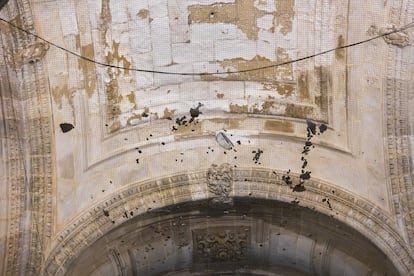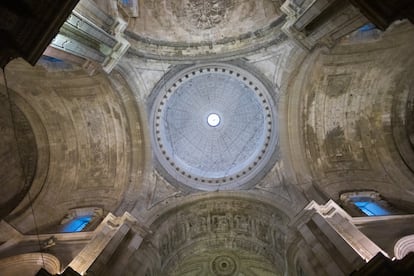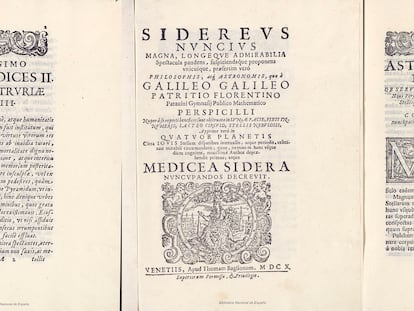The ‘salt curse’ threatening Cádiz cathedral in southern Spain
The risk of crumbling masonry inside the building remains high, yet no significant restoration work has been undertaken on its battered vaults for the past 10 years

In 1838, just three months after the consecration of the newly completed cathedral in the southern Spanish city of Cádiz, the cleric Domingo González Villanueva raised the alarm. Referring to its brand new vaults, he warned officials in the cathedral chapter that “stone slabs and somewhat larger pieces are falling.” What should have been a glorious celebration of more than a century’s tortuous work was undermined by concern. Now, 183 years later, salt continues to erode the 3,100 square meters of roofing. On January 29, a piece of masonry came loose from the façade, in a reminder to the authorities that it has now been a decade since any significant restoration work has been carried out; and that the blueprint to tackle the issue drawn up at the request of the Andalusian regional government is still to be executed.
The piece of rubble from the façade, which landed in the cathedral’s courtyard without causing injury, is not the only sign that the salt curse still threatens to wreak havoc. Repeated instances of falling masonry led to the building being closed between 1969 and 1983, and also to the installation in 1989 of a large net that stretches under all its interior vaults. The decision was made after the fall of a large block of masonry that shattered one of the pews mere days before the celebration of a First Communion mass.
The crumbling of the vaults can be seen at a glance. The corroded blocks of stone constantly cause pieces of rubble to fall into the net, which is emptied periodically. Juan Jiménez Mata, the architect who installed the net over 30 years ago, is unable to say how much weight it would stand in the event of a major incident.

Building work on the cathedral began in 1722 as a project that would reflect the prosperity of a city enriched by trade with the Americas. But it wasn’t finished until well into the 19th century, using a poorer type of stone as the city was entering a crisis from which it would never really emerge. As Juan Alonso de la Sierra, one of building’s top experts, says: “The cathedral reflects the city’s own trajectory.”
The cathedral was built with 24 different kinds of stone, first under the direction of architect Vicente Acero, who introduced hints of the Baroque style though later architects would tend more to neoclassicism and academicism. But it is specifically the kind of building material known as Estepa limestone that has plagued the edifice. As Juan Jiménez Mata, the architect behind the last 16 major restoration projects, explains the problem. “When there was less money, this stone was used in the areas above the cornices. The trouble is that this stone is softer and reacts far worse to the weather.” The damage would be similar to that endured by many other great monuments if it were not for the salt in the air that penetrates the walls. “The cathedral is an immense salt factory,” adds Jiménez Mata.
The building was constructed using mortar made from beach sand and water extracted from a brackish well located in the crypt. According to the architect Alberto Jiménez, the son of Juan Jiménez Mata, “when the tides were high the mortar did not set, and the lime turned to dust.” This caused the vault’s ashlars to be held in place by nothing more than fragments of material used to fill gaps, generating tension and causing the soft masonry to break. The proximity to the sea does the rest: the salt dissolves with the humidity, penetrates the ashlars and breaks them when it crystallizes again on dry days.

The salt curse could have been contained if the cathedral had not also had long periods when it was open to the elements. Between the 18th and 19th centuries, it spent 40 years without a roof. Then in 1947, an explosion left the building without windows for years.
There is a laborious and expensive solution to the problem, which involves filling the empty joints with new mortar and replacing the lost stones with new pieces of masonry. It is the solution that the Jiménez Mata studio has resorted to for the last 30 years during which some sections have been restored, such as the lower sacristy or the Chapel of the Relics. Extending this solution to the 3,100 square meters of vaults would cost €15 million. At least this is the sum that Juan Jiménez Mata calculated in 2009 when the Andalusian government’s department of culture commissioned him to draw up a blueprint listing priorities and laying out how the restoration work should be tackled. It has been more than a decade ago now since the architect delivered the document to the cathedral’s college of clerics and to the regional government. When questioned on the matter by EL PAÍS, the culture department’s representatives in Cádiz had no idea why the architect’s master plan has still not been approved.

It is also more than 10 years since the cathedral last carried out major restoration in its battered vaults. During this time, neither the regional nor the central authorities have come up with the necessary funding, although from 1998 to 2009 they invested €1.5 and €2.3 million respectively in other restoration projects.
Meanwhile, the cathedral chapter’s efforts have been focused on annual maintenance for the roofs and on emptying the net installed by Juan Jiménez Mata 32 years ago to catch falling debris, as well as occasionally restoring chapels and sculptures. The Cádiz Culture Delegation has authorized various restoration projects during this period, the last of which concerned the Chapel of the Assumption, the first in the cathedral to be built. But tackling the damage to the stones in the various vaults does not show up on the to-do list of the last 10 years.
Fabián Pérez, who has regularly collaborated in the cathedral’s restoration work as part of the Ars Nova studio, defends the work of the cathedral’s officials. “The chapter’s efforts to restore movable and immovable assets is remarkable. It hasn’t stopped even with the pandemic.” However, the institution has rejected three requests by EL PAÍS to explain how much it has invested and whether it is following the blueprint’s list of priorities.
Meanwhile, the Jiménez Mata family is concerned about the absence of major work on the increasingly ravaged vaults. “There should be a group of contracted masons, led by an architect, constantly reviewing roofs and cornices,” says Juan Jiménez Mata. “We are not asking for the work to be entrusted to us, but we do ask that the people who intervene in the restoration of historical heritage be assessed with transparency and a public tender,” adds his son Alberto.
Almost two centuries after the cleric González Villanueva realized that the cathedral’s construction was riddled with problems, the curse of the salt continues to eat away at it with no solution in sight. As Alberto Jiménez Mata says, “pieces of rubble continue to fall, but the size of them is a lottery.”
English version by Heather Galloway
Tu suscripción se está usando en otro dispositivo
¿Quieres añadir otro usuario a tu suscripción?
Si continúas leyendo en este dispositivo, no se podrá leer en el otro.
FlechaTu suscripción se está usando en otro dispositivo y solo puedes acceder a EL PAÍS desde un dispositivo a la vez.
Si quieres compartir tu cuenta, cambia tu suscripción a la modalidad Premium, así podrás añadir otro usuario. Cada uno accederá con su propia cuenta de email, lo que os permitirá personalizar vuestra experiencia en EL PAÍS.
¿Tienes una suscripción de empresa? Accede aquí para contratar más cuentas.
En el caso de no saber quién está usando tu cuenta, te recomendamos cambiar tu contraseña aquí.
Si decides continuar compartiendo tu cuenta, este mensaje se mostrará en tu dispositivo y en el de la otra persona que está usando tu cuenta de forma indefinida, afectando a tu experiencia de lectura. Puedes consultar aquí los términos y condiciones de la suscripción digital.
More information
Últimas noticias
There is as much life left to discover on planet Earth as that which is already known
Dozens presumed dead, around 100 injured in fire at Swiss Alps bar during New Year’s celebration
Is porn for women different from conventional porn? We spoke to those who make it
Cartagena de Indias is sinking: What can the city do to mitigate it?
Most viewed
- Sinaloa Cartel war is taking its toll on Los Chapitos
- Reinhard Genzel, Nobel laureate in physics: ‘One-minute videos will never give you the truth’
- Oona Chaplin: ‘I told James Cameron that I was living in a treehouse and starting a permaculture project with a friend’
- David King, chemist: ‘There are scientists studying how to cool the planet; nobody should stop these experiments from happening’
- Why the price of coffee has skyrocketed: from Brazilian plantations to specialty coffee houses











































